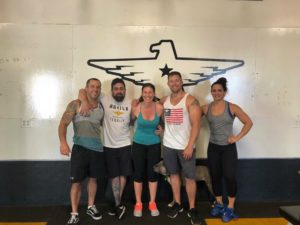EMOTM 15 Min
3 Squats 80-85%
AMRAP 10 Min
10 Sit Ups
10 Mid Thigh Step Ups
10 DB Bench Press
Over the weekend I posted a blog comparing different sports in how their athletes' skills might transfer to CrossFit. Multiple people referenced their displeasure in my assessment that distance running does not lend itself to an easy CrossFit crossover (when compared against those other sports). Though I'm going to stick by my guns that distance running tends to create inflexible/weaker individuals I will say I believe running (even for distance) CAN be an effective training tool when programmed appropriately and not at the expense of other physical "skills."
Runners, rowers, cyclists, swimmers, and cross-country skiers (not to leave anyone out) develop their aerobic energy system to a greater extent than any other named sports. These sports are essentially tests of aerobic capacity which IS ABSOLUTELY relevant to CrossFit. In the context of my last post I was referring to running long distance as a single training modality (without other athletics), not running in combination with other endeavors. If you are a powerful, flexible, coordinated individual (probably from growing up an active kid…not developed through running) who took up running distance you may have an easy transition.
CrossFit often describes fitness as "work capacity across broad times and modal domains." To put this in layman's terms it is the ability to keep working/moving at a certain pace and expressing that power through different outlets. Work capacity (the 2nd spot on the CrossFit pyramid–metabolic conditioning) comes before gymnastics/weightlifting because it is more important than the other features for fitness. If you cannot move the task is irrelevant. Depending on your capabilities and athletic grooming, you may find yourself breathless and unable to move (conditioning is too low) or feeling just fine but not able to express power through that domain (you haven't acquired that ability like a muscle-up or a certain load on a heavy clean). The runner likely fits into the second category more frequently than the first.
This brings me to my next point (I know you can't believe there's more)… two people can finish the same workout in the exact same period of time and yet may have very different experiences in regards to where they struggle and how they feel during and after. On this task, by CrossFit's definition, the athletes are equally fit yet should train in different manners to improve. An athlete with great aerobic capacity might catch their breath and walk away while the other may feel crippled because they were forced to use more demanding energy systems (anaerobic/lactic). Making note of how you feel during and after your workout can provide indications into what energy system was used and whether it was the intensity or the domain that was limiting.
So, in defense of runners, though I stand by my point that running long distances alone does not develop the athletic attributes necessary to succeed in CrossFit, it is one of the best ways to improve your aerobic conditioning (in part because you don't stop running like you put down a kettellbell). Athletes from distance running backgrounds don't seem as overwhelmed from longer CrossFit "met-cons" as those who've not developed their aerobic capacity. They tend to utilize their aerobic system faster and have a higher aerobic threshold (the point when you can no longer get enough oxygen to support the amount of work you are doing and must thus dip into anaerobic sources of energy–tends to be more painful). Additionally, they tend to recover faster because they don't have to filter the lactic acid from their blood stream. Ultimately I am saying there can be benefits of longer runs (even long slow runs..that's right, I said it) if used appropriately and not at the expense of other areas of fitness…
Just make sure you recognize people are judging the way you run (I cannot recall the original poster of the video and will not claim finding it. Say "dibs" to claim credit.






brother mike
Blake, blogs should be like women’s skirts: long enough to cover everything but short enough to be interesting.
That said, one of my new year’s resolutions fits into what you discuss in Paragraph 3, metabolic conditioning versus gymnastics/weightlifting. I like to describe this in terms of the engine and the transmission- as a runner, I have a decent engine, but there are parts of the transmission that can’t put out the power. My goal for the year was to work on getting the trasmission to match the engine- specifically upper body power.
Oh, and if the long run still has a place come out with me some Sunday for a long run.
Justin Riley
Running and other endurance sports are not fun. They beat you up and wear your body down without creating neuro-endocrine response that helps you build back stronger. Endurance athletes are less flexible, less coordinated and more often injured. They also tend to lack anaerobic conditioning. In fact long distance athletes are the least physically capable outside their sports than almost any other type of athlete.
So what do you get from endurance training? Mental toughness. That’s about it. I cannot overstate the value of mental toughness, but I think there are better ways to develop it. The long run should be few and far between even if you are one of the silly few who still wants to get a PR on your marathon and qualify for Boston again.
Lance Poulsen
I am just glad to get a great work out at CFES for the day! I don’t have the time for anything else! See you all at 4:30. Going to the zoo this afternoon.
Scott
Justin: I’m guessing long distance walking doesn’t count for much either.
Scott
Blake: nice post. The more we learn about what the dynamics of the fitness are all about, the better.
Steve
uh-oh…running blog posted, no WOD on website? What could that mean?
Scott
For what it’s worth, I’m working on an assignment that involves reviewing Tyler Hamilton’s 60 Minuties interview discussing Lance Armstrong (the doping scandal grand jury stuff). At one point Hamilton says that professional racing put him in terrible shape — way too thin.
I don’t know anything about cycling. But it just makes sense to me that the broadest approach to exercise is going to work for most people. For me it’s just a question of what’s the right mix for me.
adam k
For anyone who’s been curious, I think I’ve figured out the energy measurement differences in the Watt bike and the Airdyne. (Feel free to stop reading now.)
Watt Bikes report actual kJ (kiloJoules) of work(=Force x Distance) done.
Airdynes report an estimate of Calories (kiloCalories to be exact) BURNED, calculated by assuming a ~25% metabolic efficiency.
4.184 kJ = 1 Cal
i.e. On the airdyne: You did 2000 kJ or 478 Cal of work, but you are only 25% efficient at converting metabolic energy into physical work, therefore your body expended somewhere around 2,000 Cal.
So that’s why the numbers are so similar but it would all depend on what magic efficiency percentage is programmed into the Airdyne.
brother mike
Scott, there is cycling, then there is professional cycling. Tyler Hamilton was known as a climber, generally he was a domestique that would help the team captain control the pace in the mountains. Climbing on a bike is all about power to weight ratios. Tyler was never a very powerful rider, so the way for him to get better was 1- lose weight and 2- inject someone else’s blood (I think he intended to inject his own blood and there was a mix up which means he is lucky he did not have worse consequences than being banned from cycling for 2 years).
Matt P
Adam… Nerd.
adam k
Matt… damnproudofit.
christian louboutin outlet
The long run should be few and far between even if you are one of the silly few who still wants to get a PR on your marathon and qualify for Boston again.